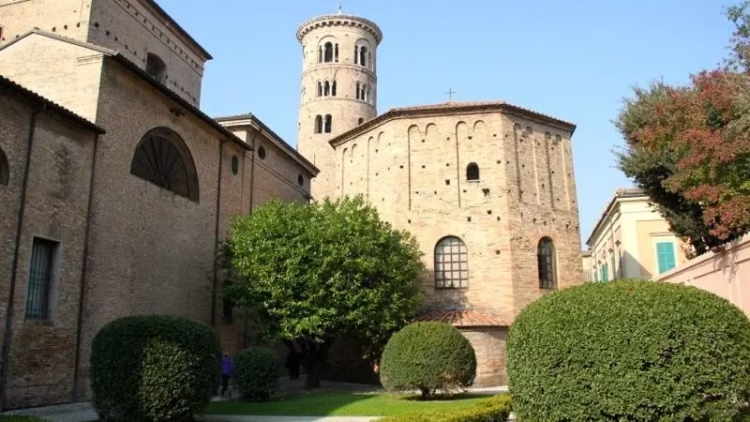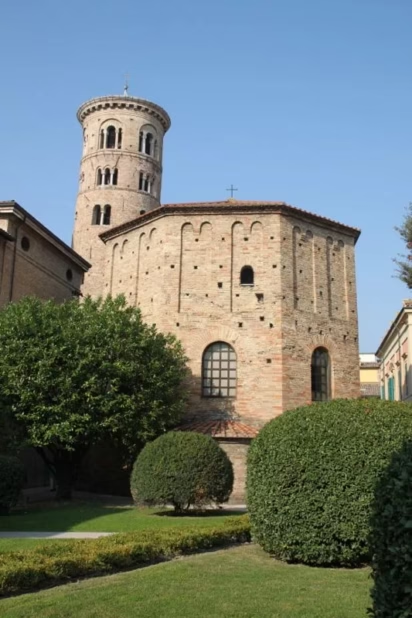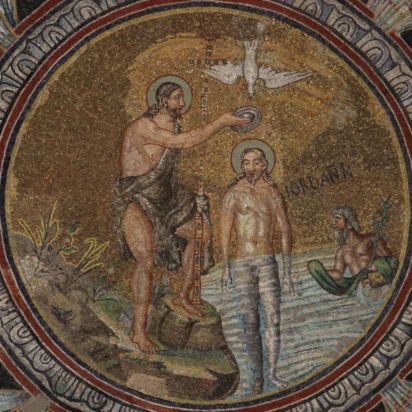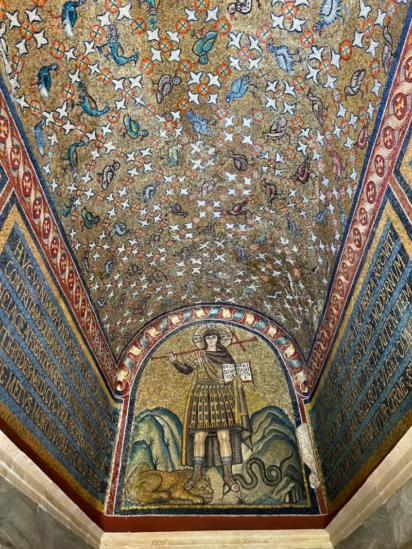The Neonian Baptistery and the Archiepiscopal Chapel are two of the smaller UNESCO-listed sites in Ravenna with superb wall mosaics.
The Neonian Baptistery and the Archiepiscopal Chapel are two of the eight UNESCO World Cultural Heritage-listed sites in Ravenna as excellent examples of early Christian monuments and Late Antiquity wall mosaics. Both are adjacent to the Ravenna Cathedral, as both were closely associated with the main center of Christian worship. The Neonian Baptistery is the oldest of the octagonal Christian structures in Ravenna while the Archbishop’s Chapel is the oldest surviving private Christian oratory. The Archbishop’s Chapel is on the second floor of the former bishop’s palace, which is now the Archiepiscopal Museum. Time-slot reservations are needed to see the Neonian Baptistry.
Neonian Baptistery in Ravenna
The Neonian Baptistery (Battistero Neoniano) is an octagonal brick building erected in the early fifth century. The mosaics were added slightly later, around AD450, by Bishop Neone, which explains the name.
The Neonian Baptistery is also referred to as the Orthodox Baptistery (Battistero degli Ortodossi) to distinguish it from the very similar Arian Baptistery.
The Neonian Baptistery is the earliest of the octagonal Christian buildings in Ravenna and one of the best-preserved examples of a baptistery from Late Antiquity.
It was originally part of a huge basilica, destroyed in 1734, which helps to explain its outsized proportions.
Like other structures from Antiquity in Ravenna, the Neonian Baptistery has sunk into the soft sand and is now around 3 m below ground level. It was partly built over a Roman bath, so some foundations might be even older.
Mosaics of the Neonian Baptistery

Inside, the Neonian Baptistery has four apses and a large central dome. The ambo is original but the baptismal font was rebuilt during the fifteenth century.
The mosaics in the Neonian Baptistery are mostly original but were a bit over-restored during the nineteenth century, with the restorer adding some artistic license unacceptable by modern restoration norms.
The dome mosaics show Christ being baptized by St John the Baptist. The faces were restored during the nineteenth century and the vessel in John’s hand is new. Below this medallion mosaic is a band with the twelve apostles and eight panels showing scenes from the Holy Land. The dark blue background broke with the Byzantine tradition of golden mosaics.
The composition of the mosaics in the Orthodox Baptistery is very similar to that of the Arian Baptistery but a notable difference is that Christ in the Neonian Baptistery mosaic is shown with a beard, while in the Arian Baptistery is beardless and clearly younger. Both shows Christ with full frontal nudity, but in the Arian mosaic, Christ is suspended in the water without standing on solid rock. The old man in both mosaics represents the pagan River Jordan god, but he is less prominent in the mosaic of Neone.
The Neonian Baptistery is in the garden to the north of the Ravenna Cathedral and the cylindrical campanile.
- See Visiting UNESCO-Listed Churches and Mosaics in Ravenna for opening hours and ticket information. (Buy tickets from the nearby Archbishop’s Museum, or better, online, as time-slot reservations are currently necessary to see this baptistery to limit visitors due to its small size.)
Archbishop’s Chapel of St Andrew in Ravenna

The Archiepiscopal or St Andrew’s Chapel (Capella Arcivescovile o di Sant’Andrea) was the private oratory of the bishops of Ravenna. It was constructed around AD 500 with the mosaics dating from the same period.
The chapel with a Greek cross floor plan was originally dedicated to Christ the Savior but is currently dedicated to St Andrew. The vaults have their original mosaics, but Lucca Longhi painted other parts of the higher walls during the sixteenth century.
The mosaics feature strong anti-Arian iconography as the Latin Orthodox clergy were generally keen to distinguish themselves from the Ostrogothic Arian rulers, who settled in Ravenna during Late Antiquity. (See Arian Baptistery in Ravenna for more on that period and Arianism.)
The main lunette features Christ as a warrior. Christ is dressed like a victorious emperor standing on the beast and a snake. The vault mosaics almost resemble a carpet or tapestry of birds and patterns. (Although a beardless Christ was more common in Arianism, a smoothly shaved Christ was not unknown in orthodox art.)
The Archbishop’s Chapel is the smallest of the UNESCO World Cultural Heritage-listed sites in Ravenna but absolutely worth seeing. The chapel is on the first floor of the Archbishop’s Museum (Museo Arcivescovile) and is easily overlooked, as the museum has a number of other small rooms and narrow passages. (The museum itself is not very big and the highlights can easily be seen in half an hour.)
- See Visiting UNESCO Listed Churches and Mosaics in Ravenna for opening hours and ticket information.
NEXT: The Arian Baptistery in Ravenna
More Articles on Ravenna, Italy

Time-slot reservations are currently essential to see the Mausoleum of Galla Placida and the Neonian Baptistry in Ravenna. This is easiest done when buying the tickets online.
- Top Sights to See in Ravenna
- UNESCO-Listed Sites in Ravenna
- Visiting UNESCO-Listed Sites in Ravenna – Opening Hours and Tickets
- Neonian Baptistery & Archbishop’s Chapel
- Arian Baptistery
- Basilica of Sant’Apollinare Nuovo
- Basilica of San Vitale
- Mausoleum of Galla Placidia
- Mausoleum of Theodoric
- Basilica of Sant’Apollinare in Classe
- National Museum of Ravenna
Book Guided tours of Ravenna — tours are generally three hours. For tours not including admission fees, around €12 per person must be added. Small groups and families may find better value in private tours.



